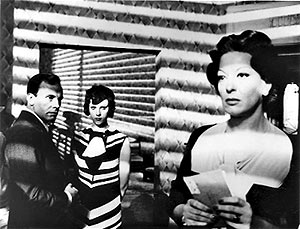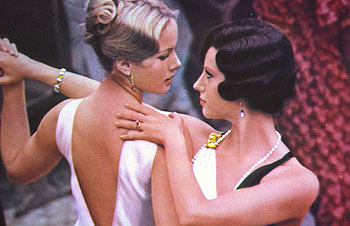Dark City Is Overrated
Published on January 30th, 2009 in: Issues, Movies, Over the Gadfly's Nest |
The Conformist, 1970
Many of Dark City‘s fans and detractors sing the praises of the film’s look. In an otherwise negative review, Entertainment Weekly critic Ty Burr describes the film as “visually sumptuous,” and Harvey Karten (from AllMoviePortal.com) likewise cites its “visual grandeur” as its only virtue. Indeed, the production and costume design and cinematography hold a stylized, proto-steampunk appeal. Unfortunately, I was only able to notice this appeal from looking at production stills. Why is this, you might ask? In a word, editing.
Dark City is the most inappropriately-edited feature film I’ve seen in quite some time. A capsule review of the Director’s Cut DVD in Boston’s Weekly Dig states that the average shot length is two-and-a-half seconds. Now, there’s a place for this kind of shoot-for-the-edit style. Given the dystopian confusion of the film’s story, starting out with disorienting, rapid cuts puts the audience in an appropriate state of mind. However, the film keeps up this breakneck editing throughout the entire running time. Using such post-MTV style editing creates a false sense of suspense that better filmmakers would create through such old-fashioned techniques as character and story. It also fails to allow the audience to get into—or even be able to follow—the plot.
Dark City arrived in theatres about four years after the restoration and re-release of Bernardo Bertolucci’s 1970 masterpiece The Conformist (Il Conformista). Like Proyas’s feature, The Conformist takes place in a gilded art-deco world—in this case, Mussolini-era Italy and France—and draws on stylized performances and editing to engage its audience. Unlike Proyas, Bertolucci worked with many film noir tropes while also folding in some new elements. There is much more to be said about the roles of philosophy and modern psychology in the film, but in short, Bertolucci revolutionized neo-noirs with his mix of larger-than-life character acting (Stefania Sandrelli, Gastone Moschin) and the more naturalistic performances in the film (Jean-Louis Trintignant, Dominique Sanda).

This is more like it: Dominique Sanda and Stefania Sandrelli
Bertolucci’s notion of the film noir protagonist as an Easy Rider/Raging Bull-era antihero is so surprising, yet unheard of at that point in film history that it’s hard to believe no one thought of it before. This characterization would influence many legitimately classic films of that era and beyond. If you enjoyed Chinatown (for starters), you have Bertolucci to thank. No less an authority on neo-noir than Roger Ebert gave The Conformist high praise on its 1994 re-release, though he could promote it further by, say, recording a commentary track for its long-awaited DVD release. This doesn’t change the fact that The Conformist is like listening to a bravura jazz trio reinvent the classics in ways you might not have otherwise predicted, while Proyas’s much-lauded, yet inferior directorial effort is like hearing a cover band with a fast drummer and a way-out-of-tune backup singer.
Pages: 1 2
Time limit is exhausted. Please reload the CAPTCHA.